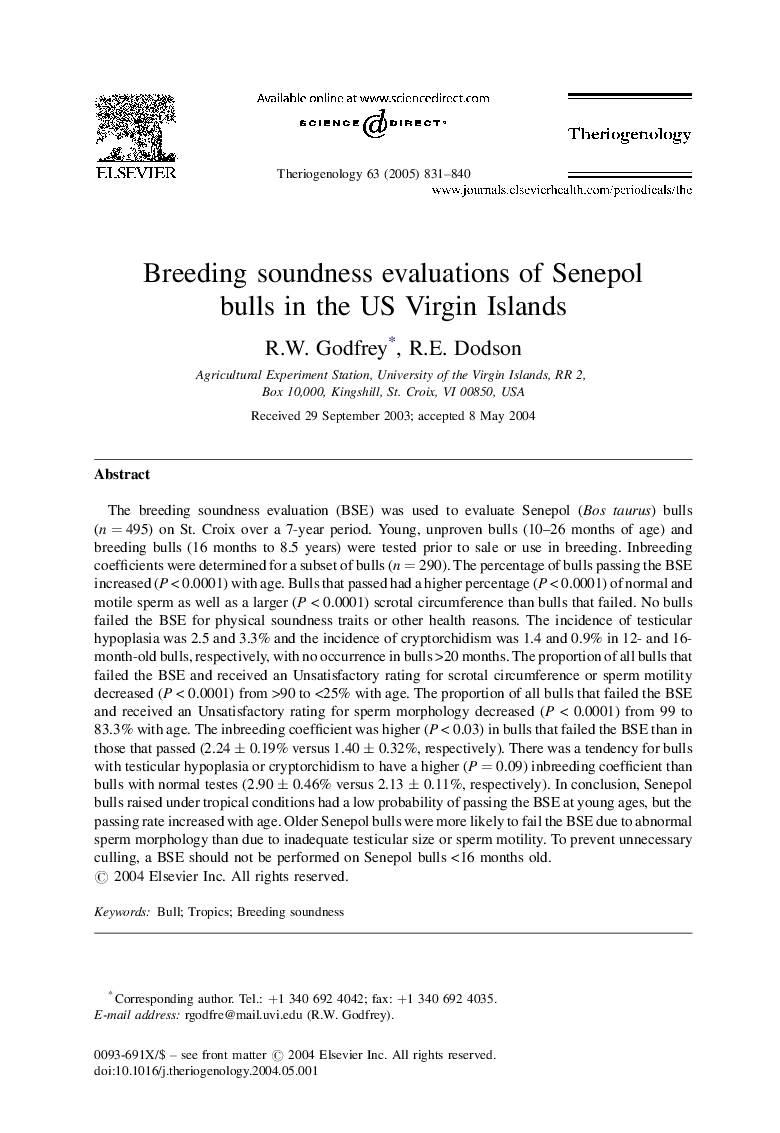| کد مقاله | کد نشریه | سال انتشار | مقاله انگلیسی | نسخه تمام متن |
|---|---|---|---|---|
| 10894595 | 1082594 | 2005 | 10 صفحه PDF | دانلود رایگان |
عنوان انگلیسی مقاله ISI
Breeding soundness evaluations of Senepol bulls in the US Virgin Islands
دانلود مقاله + سفارش ترجمه
دانلود مقاله ISI انگلیسی
رایگان برای ایرانیان
موضوعات مرتبط
علوم زیستی و بیوفناوری
علوم کشاورزی و بیولوژیک
علوم دامی و جانورشناسی
پیش نمایش صفحه اول مقاله

چکیده انگلیسی
The breeding soundness evaluation (BSE) was used to evaluate Senepol (Bos taurus) bulls (n = 495) on St. Croix over a 7-year period. Young, unproven bulls (10-26 months of age) and breeding bulls (16 months to 8.5 years) were tested prior to sale or use in breeding. Inbreeding coefficients were determined for a subset of bulls (n = 290). The percentage of bulls passing the BSE increased (P < 0.0001) with age. Bulls that passed had a higher percentage (P < 0.0001) of normal and motile sperm as well as a larger (P < 0.0001) scrotal circumference than bulls that failed. No bulls failed the BSE for physical soundness traits or other health reasons. The incidence of testicular hypoplasia was 2.5 and 3.3% and the incidence of cryptorchidism was 1.4 and 0.9% in 12- and 16-month-old bulls, respectively, with no occurrence in bulls >20 months. The proportion of all bulls that failed the BSE and received an Unsatisfactory rating for scrotal circumference or sperm motility decreased (P < 0.0001) from >90 to <25% with age. The proportion of all bulls that failed the BSE and received an Unsatisfactory rating for sperm morphology decreased (P < 0.0001) from 99 to 83.3% with age. The inbreeding coefficient was higher (P < 0.03) in bulls that failed the BSE than in those that passed (2.24 ± 0.19% versus 1.40 ± 0.32%, respectively). There was a tendency for bulls with testicular hypoplasia or cryptorchidism to have a higher (P = 0.09) inbreeding coefficient than bulls with normal testes (2.90 ± 0.46% versus 2.13 ± 0.11%, respectively). In conclusion, Senepol bulls raised under tropical conditions had a low probability of passing the BSE at young ages, but the passing rate increased with age. Older Senepol bulls were more likely to fail the BSE due to abnormal sperm morphology than due to inadequate testicular size or sperm motility. To prevent unnecessary culling, a BSE should not be performed on Senepol bulls <16 months old.
ناشر
Database: Elsevier - ScienceDirect (ساینس دایرکت)
Journal: Theriogenology - Volume 63, Issue 3, February 2005, Pages 831-840
Journal: Theriogenology - Volume 63, Issue 3, February 2005, Pages 831-840
نویسندگان
R.W. Godfrey, R.E. Dodson,